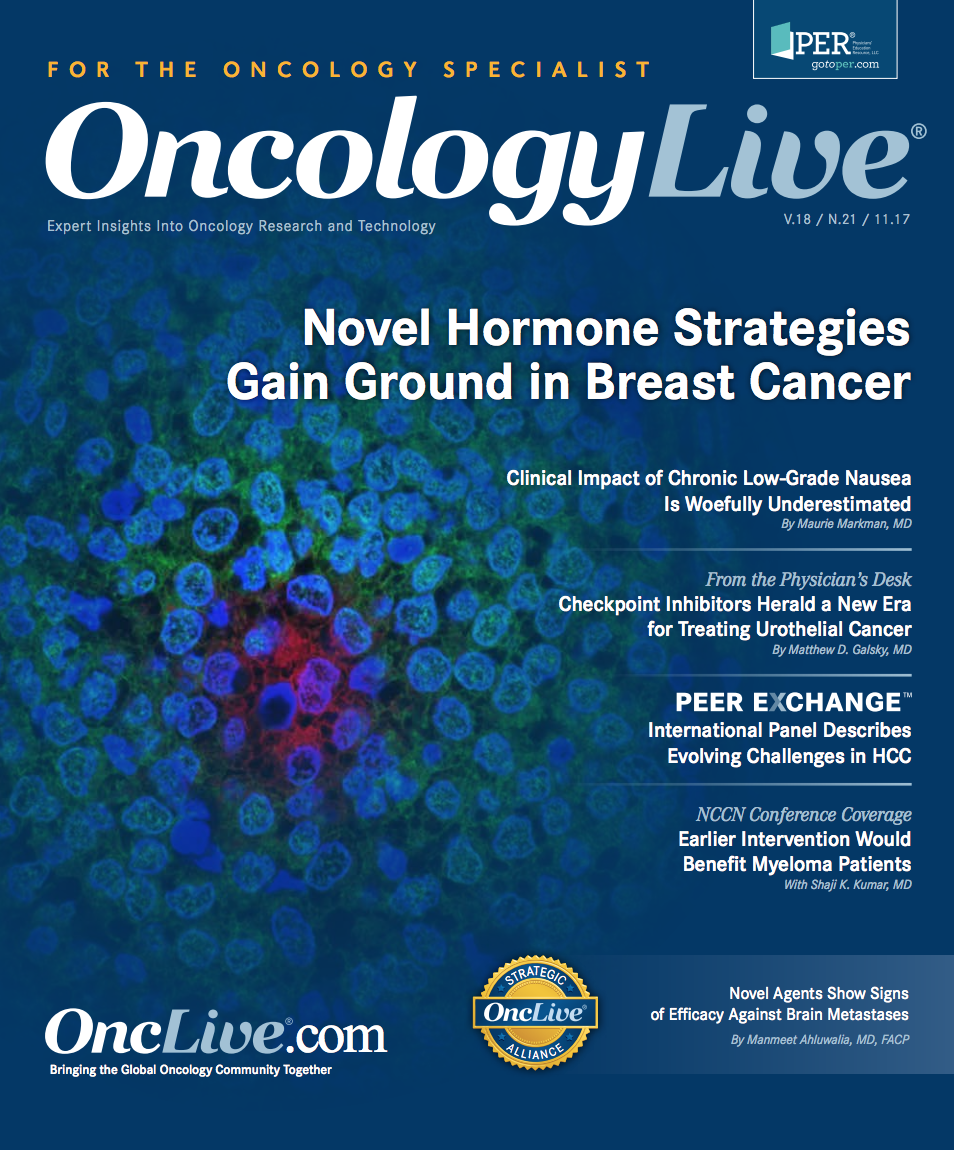Publication
Article
Oncology Live®
Triplet Therapy With Selinexor Tested in Myeloma
Author(s):
Selinexor, a novel drug that targets a tumor-suppressor “cargo” protein mechanism, is being investigated in patients with relapsed/refractory multiple myeloma who have received 1 to 3 prior treatment regimens.
Sundar Jagannath, MBBS
Selinexor (KPT-330), a novel drug that targets a tumor-suppressor “cargo” protein mechanism, is being investigated in patients with relapsed/refractory multiple myeloma (MM) who have received 1 to 3 prior treatment regimens. The BOSTON trial, which is currently enrolling participants, is seeking to assess the safety of selinexor in combination with standard-of-care treatment including a proteasome inhibitor and a glucocorticoid.
The small molecule is being administered in combination with bortezomib (Velcade) and dexamethasone in the phase III BOSTON trial (NCT03110562). Eligible patients will have documented evidence of relapsed/refractory MM after at least 1 treatment regimen but no more than 3 prior regimens, which may include bortezomib or another proteasome inhibitor. Participants must also have no central nervous system involvement.
The multicenter international trial will randomize an estimated 350 adult participants to receive either the 3 drugs in combination or bortezomib and dexamethasone alone (Figure). The primary endpoints are progression-free survival and overall response rate (ORR). Notably, patients who have progressive disease while on bortezomib and dexamethasone will have the option to cross over to the experimental arm to be treated with selinexor.
Figure. Selinexor in Relapsed/Refractory Multiple Myeloma
Selinexor inhibits chromosomal maintenance protein exportin-1 (XPO1), a nuclear export protein that mediates the transport of more than 200 cargo proteins, including most tumor-suppressor proteins.1 The drug works to block the export process by binding to other proteins within the nucleus of the cell and shuttling them through the nuclear pores into the cytoplasm in the rest of the cell.
“You basically keep all the tumor-suppressive proteins within the nucleus, and they will lead to tumor suppression with a deleterious effect, finally causing the cancer cells to die,” said Sundar Jagannath, MBBS, professor of medicine and director of the myeloma program at the Tisch Cancer Institute at the Icahn School of Medicine at Mount Sinai in New York City.
“Because selinexor has a completely different mechanism of action, it blocks communication from the nucleus to the cytoplasm, and once that transportation system is blocked, the cell is paralyzed and goes through apoptosis,” said Jagannath, who is the principal investigator for the BOSTON trial.
Additionally, selinexor inhibits XPO1 from exporting the glucocorticoid receptor to which corticosteroids bind. By keeping the glucocorticoid receptor in the nucleus, it potentiates the effects of steroids in the cell. In MM, corticosteroids can induce their own clinical response, and selinexor works with the other agents to increase their efficacy. Jagannath said patients in this clinical setting need additional options. “These patients have an unmet medical need in that they have a short life expectancy, so we want to look for a treatment that will improve their outcome,” he said.
The selinexor-containing triplet regimen has demonstrated positive responses in heavily pretreated patients with MM in the ongoing phase IB/II STORM trial, according to findings presented at the 2016 American Society of Hematology Annual Meeting.2 Seventeen of 22 patients who were treated with selinexor in combination with bortezomib and dexamethasone responded to therapy for an ORR of 77%; the ORR consisted of complete responses (CRs), stringent CRs, partial responses (PRs), and very good PRs. The ORR was 67% among the 15 refractory patients in the cohort.2 The most common adverse events (AEs) associated with selinexor are fatigue, anorexia, nausea, and vomiting. Other AEs seen in past studies have included low blood counts, primarily thrombocytopenia, and, to some extent, neutropenia, anemia, and hyponatremia.
Overall, selinexor in combination with bortezomib and dexamethasone is highly active and well tolerated in patients with heavily pretreated MM. Common grade 1/2 AEs observed in the phase I STOMP trial included fatigue (41%), nausea (41%), anorexia (36%), and weight loss (18%). Common grade 3/4 AEs included thrombocytopenia (41%), anemia (18%), and neutropenia (18%).2
Selinexor has the potential to provide a novel option for a large subset of patients. “I think this drug will be beneficial not only for myeloma; I think the mechanism of action may turn out to be good for many other cancers as well,” said Jagannath. The drug is also under investigation in diffuse large B-cell lymphoma, liposarcoma, gynecologic malignancies, and glioblastoma, according to Karyopharm Therapeutics, which is developing selinexor. It is among several novel compounds using SINE (selective inhibitor of nuclear export) technology that Karyopharm has in its pipeline.
References
- Overview. Karyopharm Therapeutics website. karyopharm.com/about/. Accessed November 1, 2017
- Bahlis NJ, Kotb R, Sebag M, et al. Selinexor in combination with bortezomib and dexamethasone (SdB) demonstrates significant activity in patients with refractory multiple myeloma (MM) Including proteasome-inhibitor refractory patients: results of the phase I Stomp trial. Presented at: 2016 American Society of Hematology Annual Meeting; December 3-6, 2016; San Diego, CA. Blood. 2016;128(22):977. bloodjournal.org/ content/128/22/977.

























%20(2)%201-Recovered-Recovered-Recovered-Recovered-Recovered-Recovered-Recovered-Recovered-Recovered-Recovered-Recovered-Recovered-Recovered-Recovered-Recovered-Recovered-Recovered.jpg?fit=crop&auto=format)
%20(2)%201-Recovered-Recovered-Recovered-Recovered-Recovered-Recovered-Recovered-Recovered-Recovered-Recovered-Recovered-Recovered-Recovered-Recovered-Recovered-Recovered-Recovered.jpg?fit=crop&auto=format)
